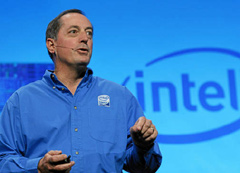
(Note: Last week I sat down with Intel’s Paul Otellini to talk about technology in the 2-to-5-year future. Can Moore’s Law continue? What will smartphones, tablets and PCs look like in two years? I will publish our conversation in the March 14 issue of Forbes magazine. Meanwhile, enjoy Otellini’s riff on Intel’s amazing 43-year-old corporate culture. Steve Jobs may be the iconic entrepreneur/CEO of Silicon Valley, but Intel, I would argue, is the iconic culture.)
Name a Silicon Valley giant that has managed CEO succession well. HP hasn’t. Sun blew it. Advanced Micro Devices never adequately replaced Jerry Sanders. Apple dropped the baton repeatedly its first incarnation – Steve Jobs to John Sculley, Michael Spindler and Gil Amelio — and it’s too early to tell if Tim Cook can replace Jobs this time around. Larry Ellison still runs Oracle, and Cisco is only on its second CEO, John Chambers. Google has gone back to its founders, and Facebook is not even yet public.
Among large companies, only Intel has mastered CEO succession multiple times. Founded in 1968, Intel has gone from founders Bob Noyce and Gordon Moore, who both served as CEOs, to Andy Grove, Craig Barrett and now Paul Otellini without losing its status as the world’s preeminent chip manufacturer. There have been scary moments, notably in the mid-1980s. Then, Intel’s memory chip cash cow was being eaten by Asian competitors and the future star, the microprocessor, was still ramping up. Intel faced scandal in 1994 when it mishandled news about flaws in its Pentium chip. In 2006, the newest CEO, Otellini, had to lay off 10% of workers in what now can be seen as a prelude to the Great Recession.
Also, Intel has disappointed shareholders over the last decade. This is true of most tech companies caught in the 2000 bubble, when Nasdaq soared over 5,000. (Apple, the exception, was a beaten down company in 2000 and did not participate in the tech bubble. Google, of course, only went public in 2004.) But you can’t blame Intel managers in 2011 that wild-eyed shareholders in 2000 gave Intel a 14-times sales and 57-times earnings multiple at the peak. Otellini’s generation has had to live with the great reset of valuations.
In the hard reality of the post recession, Intel is firing on all cylinders. Its sales in the 4th quarter of 2010 were $11.5 billion and its profit was a best-ever $3.4 billion.
Otellini joined Intel in 1974, six years after the company’s founding. He explains Intel’s amazingly durable culture.
In your 36 years, Paul, how has Intel’s culture changed — and how has it stayed the same?
“Instantaneous communication is the biggest change in my career. I can do a video that instantly goes to Intel’s 80,000 employees. Information has become a competitive advantage. Speed of business is obviously faster. Ninety percent of the revenue Intel gets in December comes from products that weren’t on the market in January. Another change is work life balance. Intel used to be a company of 8am check-ins and timecards. But now people can telecommute, take time out during the day.”
Wasn’t Andy Grove the author of Intel’s notorious time cards?
“Hah, yes. But that changed when we taught Andy email. Now Andy emails everyone all the time … (laughs) … to my eternal regret.”
What hasn’t changed in Intel’s culture?
“The commitment to deep science and engineering. Bob Noyce and Gordon Moore were Ph.D.s. Half of our 82,000 employees today have engineering degrees and a quarter have masters degrees. We have 4,000 Ph.D.s, more than most universities in the world.”
How would you summarize the Intel culture?
“Egalitarian. Merit based. That came from Noyce. Anyone can speak in a meeting, but you must speak with data. That came from Moore. Take risks. Embrace innovation, but do it with discipline. That’s Grove. World-class manufacturing came from Barrett. I’ve added a marketing component.
“The other thing unique to Intel, at least in Silicon Valley, is the mix of older and newer employees. Intel has more 20-year-plus veterans than any Silicon Valley company. I’ve been here 36 years. Yet the average age of our global workforce is 25. Tradition and innovation. We like both.”
HT: Forbes.com
